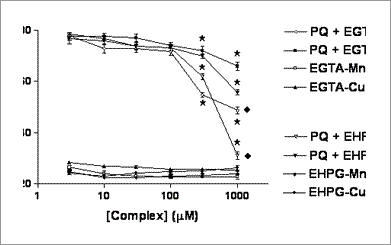Reduction of paraquat-induced nephrotoxicity by manganese and copper complexes of EGTA and EHPG Paraquat (PQ) nephrotoxicity is mediated via the production of reactive oxygen species such as superoxide anions. Recently, metal complexes of the calcium chelator ethylenebis(oxyethylenenitrilo)tetraacetic acid (EGTA) and the contrast agent ethylenebis(hydroxyphenylglycine) (EHPG) have been reported to possess varying degrees of superoxide dismutase activity (Fisher et al., 2004). The aim of this study was to investigate whether manganese(II) (Mn) and copper(II) (Cu) complexes of EGTA and EHPG could provide protection against PQ –induced toxicity of renal cells. Confluent cultures of the renal NRK-52E cell-line were incubated for 24 hours with Dulbecco’s Modified Eagle’s Medium (DMEM) with increasing concentrations EGTA-Mn, EGTA-Cu, EHPG-Mn or EHPG-Cu in the presence or absence of 1 mM PQ. Lactate dehydrogenase (LDH) released into the incubation medium was measured spectrophotometrically (Abe et al., 2000) and, on comparison with LDH released from cells treated with Triton X-100, used as an indicator of cell death (% TX control). Complexes of EGTA-Mn, EGTA-Cu, EHPG-Mn and EHPG-Cu reduced PQ-mediated release of LDH significantly at concentrations above 300 μM ( Figure 1). Mn-based complexes provided significantly greater protection than Cu-based agents ( Figure 1).
Figure 1 – Effects of Mn and Cu complexes of EGTA and EDTA on PQ toxicity of NRK-52E cells. Data represented as mean ± s.e.m., N=20, These results suggest that Mn and Cu complexes of EGTA and EHPG can reduce renal cell death caused by PQ and could be beneficial as a therapy for PQ nephrotoxicity.
Abe, K., et al. (2000) Neurosci. Res. 38, 325-329. |


